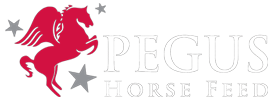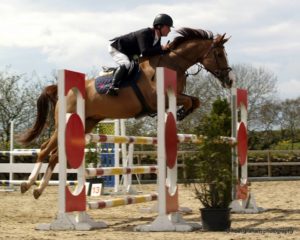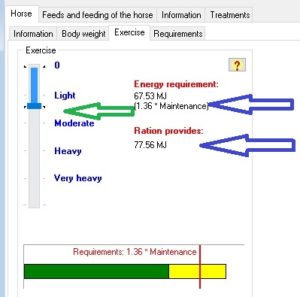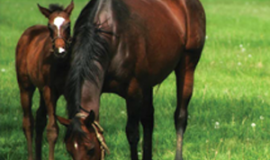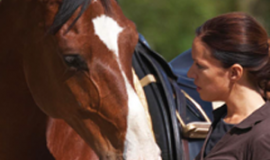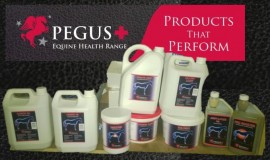Energy requirement for exercised horses…
When horses are being exercised, their energy requirement increases and the amount of energy (MJ) in the ration has to be increased accordingly. It is difficult to accurately estimate the extra energy needed as a result of exercise, and several models have been proposed. Here we will describe how Pegus Horse Feeds uses PC-Horse to calculates the energy requirement of exercised horses.
What is exercise?
Exercise can be defined as physical activity that increases oxygen consumption.This increase in oxygen consumption is dependent on the duration and intensity of the exercise. The duration of any bout of exercise is easy to measure (time). Its intensity can be measured with a heart rate monitor and is influenced by a number of factors such as speed, ground resistance and inclination, weight of rider or wagon, number of jumps etc. During a typical week, the amount of exercise will vary from days with no exercise (or maybe from just one or two days a week) to more intensive exercise bouts or competitions. When composing rations for exercised horses we therefore have to consider the average energy requirement over several days or a week.
How to define the amount of exercise
In nutritional terms, the amount of exercise can be defined as an increase in energy requirement relative to the maintenance energy requirement (NRC 2007).
This is the model we have used in Pegus Horse Feed PC Horse diet planner . We have defined different exercise levels according to how much the energy requirement has been increased above the maintenance requirement.
Light exercise: 1.25 x maintenance
Moderate exercise: 1.5 x maintenance
Heavy exercise: 1.75 x maintenance
Very heavy exercise: 2.0 x maintenance
With Pegus PC-Horse the level of exercise is presented graphically. You can click directly on each exercise level, or use the slider (green arrow) on the exercise bar. As you increase the exercise level, the energy requirement is recalculated continuously (upper blue arrow) and you will see the actual exercise level. In this example, it is 1.36 times maintenance, which is between Light and Moderate exercise.
When you have composed a ration that provides 100% of the calculated energy requirement, you will see that the figures for “Energy requirement” and “Ration provides” are identical or very close.
How can you determine the actual level of exercise for your horse?
To calculate the actual exercise level of a horse, you can do the following:
Define the horse in Pegus Horse Feed advisors. We can help select the exercise level with you which is the most appropriate. Then we will estimate as accurate as possible the body weight and the amounts (kg) of each feed given daily. Enter the feeds and the amount of each into the program (Feed analysis of the actual forage will be very useful).
If the horse is in a favourable body condition and neither gaining nor losing weight, we can assume that the energy content of the ration given is close to the horse’s energy requirement. In the Pegus Diet programme this is shown in the Exercise window as a figure under “Ration provides” (lower blue arrow in picture). Move the slider on the bar graph up or down until the figure under “Energy requirement” (upper blue arrow) is as close as possible to the figure under “Ration provides”. This will allow us to see directly the exercise level calculated for your horse. Pegus can now make any corrections needed to the ration and balance the rest of the nutrients.
Contact Pegus Horse Feed
Free Phone Helpline R.O.I.= 1800-378463 UK = 0800 011 4182
www.pegus.ie info@pegus.ie
